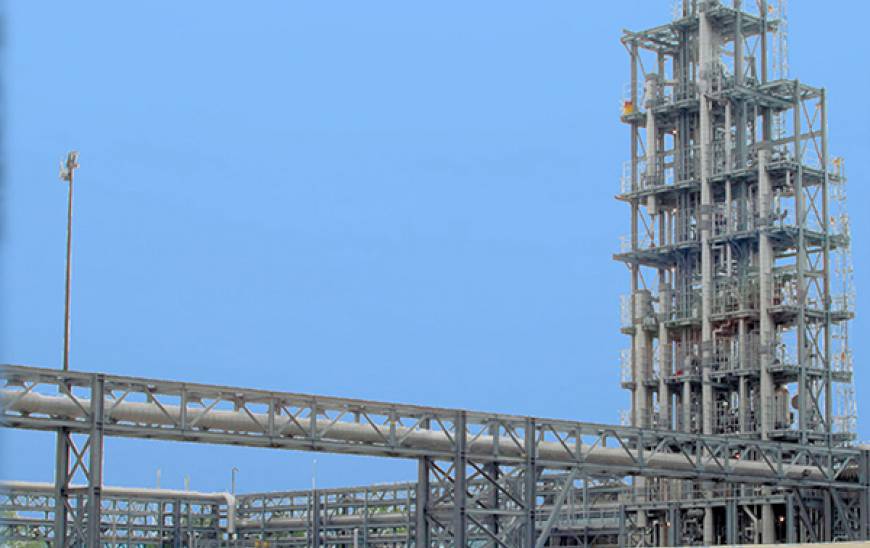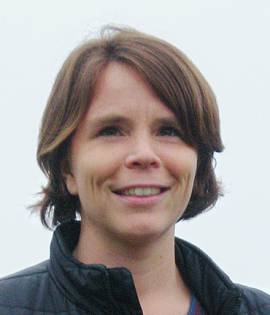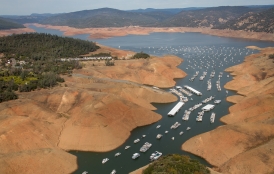The Stanford School of Earth, Energy & Environmental Sciences is now part of the Stanford Doerr School of Sustainability.
This page is currently being maintained for archival purposes only. For the latest information, please visit us here.
For carbon dioxide emissions, a backup plan to business as usual
With global carbon dioxide levels recently exceeding 400 parts per million and global carbon emissions projected to continue rising for the next several decades, the National Research Council commissioned a two-part report to learn more about potential interventions.
<p>Stanford School of Earth, Energy & Environmental Sciences</p>
March 16, 2015

<p>A test facility for post-combustion carbon capture partially funded by the US Department of Energy's National Carbon Capture Center.</p>
The National Research Council, the operating arm of the National Academy of Sciences and National Academy of Engineering, recently published a comprehensive report covering strategies of climate intervention. Within the two volumes and nearly 375 pages, they had covered many potential ways humanity might deliberately manipulate Earth’s climate systems to mitigate the effects of global warming.
The reports, titled Climate Intervention: Carbon Dioxide Removal and Reliable Sequestration and Climate Intervention: Reflecting Sunlight to Cool Earth, are the result of months of meetings and the gathering of experts who combed over years of research.
Jennifer Wilcox, assistant professor of Energy Resources Engineering at Stanford, was one of 16 authors with particular focus on the first volume dealing with carbon dioxide removal and reliable storage. (Another Stanford affiliated author is Ken Caldeira, professor by courtesy of Earth System Science who has conducted research on solar radiation management.) Wilcox has studied carbon dioxide removal for years and has published a book Carbon Capture on the subject. In the following, Wilcox explains the methods reviewed in the report.

Jennifer Wilcox
What were you and your colleagues investigating in Climate Intervention: Carbon Dioxide and Reliable Sequestration and how would you summarize the content?
This report can be considered a portfolio of options that might comprise the backup plan to our business-as-usual activities with regard to carbon emissions. We reviewed strategies that we wouldn’t necessarily want to employ today, but in light of the fact that humans continue to burn fossil fuels 24/7, we may not have a choice but to explore some of these options down the road.
We investigated what’s been done, what’s the current understanding of the proposed technologies, how they have been practiced or carried out, and at what scale. Then we looked at the balance of all of them in terms of their associated risks, their financial and energy expenses, at what scale we would need to implement them to have a significant impact, and then what future research directions we might take if we were to recommend investing in these kinds of efforts to the U.S. Department of Energy or the National Science Foundation, for example.
What aspects of climate dioxide removal, or carbon capture, did you focus on in this report?
This report addresses with how to deal with the carbon dioxide that’s already in our atmosphere. For example, two research areas we discussed were bioenergy and direct air capture. With bioenergy, we take advantage of the fact that plants and biomass – biological material derived from living things – remove CO2 from the atmosphere. If we burn the biomass instead of coal or natural gas, and if we capture and sequester the CO2 generated, then the technology has the potential to be CO2 negative.
In direct air capture, we would need to construct chemical filters that would selectively remove the CO2 as air flowed through the system. This approach requires a significant amount of energy for powering fans or blowers so that the air would come into contact with the chemicals. The benefit of direct air capture is that we could build systems almost anywhere, as long as we could connect them to a power source.

Computer model of a direct air capture tower system with fans and chemical filters.
What are the biggest challenges associated with bioenergy and direct air capture?
Bioenergy is difficult because of the required scale, but it’s also low risk. Say we were going to plant trees or switch grass to draw down CO2 and then subsequently burn the biomass. We would need a tremendous amount of land for biomass growth.
The limitations of direct air capture are associated with power. It would require about 20-25 percent of the fuel or energy produced at a single power plant to remove the CO2 released by that same plant. If you use energy generated from coal to capture CO2 from the air, you end up emitting more CO2 than you can capture. If you use energy from natural gas, you break even. Therefore, the only reasonable option is to power direct air capture systems using carbon free energy sources such as solar or wind. Again, the challenge with this approach is available land since the surface area of solar panels would be significant to fuel the process.
Given the difficulties, now can carbon capture move forward?
I think we should put research into hybrid concepts. For example, we could link carbon capture with carbon-free energy sources. At the moment, research on this approach hasn’t moved beyond the lab scale. For a conventional CO2 absorption approach, energy is required for blowers and pumps with even more energy required to heat liquid solvent for regeneration and reuse. If we could find ways to power these systems using solar or wind energy, the efficiency of the power plant could be maintained. This knowledge could also directly translate to direct air capture plants if they become a component of the portfolio of solutions for climate intervention.
What do you hope people take away from this report?
I hope that they realize that we need to focus on mitigation of CO2 emissions and adaptation to the inevitable changes to our climate. Right now, policy makers need to focus on how to reduce carbon emissions. But we also need to have an eye on the future. We can’t neglect funding for research efforts that will allow us to learn more about the opportunities and risks associated with the carbon dioxide removal strategies outlined in this report.







